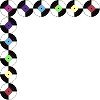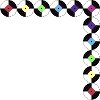
Polydor group matrix numbers are almost identical to Philips / Phonogram ones, except that that the 'A' and 'B' sides are indicated by 'A' and 'B' instead of by '1F' and '2F'. Thus we get '2058110 A//1s420' (Polydor) and '2025193 B//1s420' (Stax). There are occasional exceptions to these rules - sometimes the triangle or the '420' may be omitted or replaced by a letter, or the two forward slashes may be missing (as in the example shown above) - but the side-indicator seems to be ever present.

Two other number combinations generally appear on the run-off: '04' (sometimes '05' or '03') can often be found either at 10 o'clock or following the matrix number, and three other numbers, often with spaces between them, appear at around two o'clock. Often these three numbers consist of two '1's (sometimes one of them is reversed) and a '1', '2', '3' or '4'. 'Seb' identifies these as the 'Father number', the 'Mother number', and the 'Stamper number', in that order. Spacing varies wildly: usually the two '1's are close together, but the third number can be found near to them or anywhere else up to nine o'clock.
Labels which were pressed by Phonodisc but were not part of the Philips / Phonogram or Polydor families appear to have usually followed the Polydor style of run-off legends, for example 'RESL 31 A//1s420' (BBC) and 'EAG 0032 B//1s420' (Eagle); again, parts might be substituted, as happened to the triangle and the '420' in 'BIG 523 A//1 M' (Transatlantic), or missing altogether, like the triangle in 'MAG 005 B//1 420' (Magnum).


























































